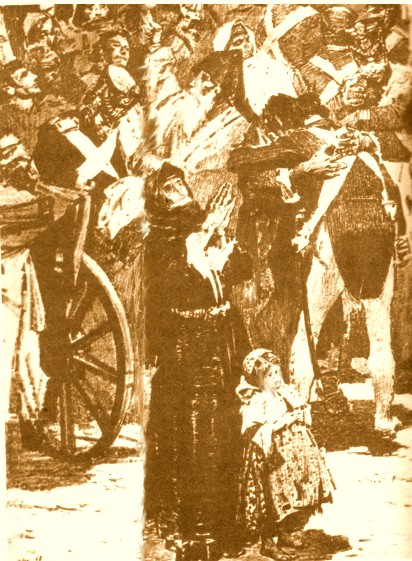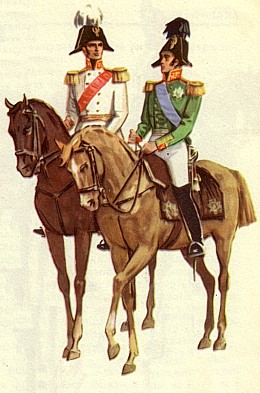![]()
![]()
ARTSAKH IN THE FOREFRONT OF
THE NATIONAL LIBERATION MOVEMENT - PART II

Written by Gevork Nazaryan
During the 1750s, having taken advantage of the civil unrest amongst the princes of Artsakh, and with the assistance of the Varanda Prince Shahnazar II, one of the semi-nomadic Turkic-speaking tribe’s leaders, Panakh, was able to infiltrate and settle down in the fortress of Shushi. He proclaimed Karabagh (a term used to denote Artsakh by the Persians before the nomadic invasions) a khanate and himself a "khan". The Persian court during this period supported the clan leader in his drive to settle down amongst the Armenian princes. The rights of local princes during this time were restricted. In Artsakh, there began the process of penetration of a foreign and alien ethnic element that later on led to the change of the areas overwhelmingly Armenian ethno-demographic structure.

1827-28 COAT-OF-ARMS OF THE ARMENIAN FREEDOM FIGHTERS
3 FLAGS ON THE RIGHT -- 3 FLAGS ON THE LEFT
DEPICTING THE HERALDIC SYMBOLS OF THE ANCIENT
ARMENIAN ROYAL HOUSES. IN THE CENTER THE
HOLY MOUNT ARARAT WITH NOAH'S ARK ON TOP
WITH INSCRIPTION 'ASTUATS ĚND MEZ
Ē'
[GOD IS WITH US]. ABOVE THE SHIELD IS THE DOUBLE HEADED
EAGLE FACING EAST AND WEST HOLDING THE ORB AND THE SCEPTER
OF ROYALTY. THE SHIELD OF SAINT GEORGE SLAYING THE DRAGON OF TYRANNY
IN THE CENTER/BODY --THE CROWN AT THE VERY TOP.

LEADING MEMBERS OF THE LAZARIAN NOBILITY WHO PLAYED AN
INSTRUMENTAL
ROLE IN THE LIBERATION MOVEMENT OF EASTERN ARMENIA FROM FOREIGN YOKE
ORIGINALLY FROM DAŠT, NAKHICHEVAN DISTANTLY
RELATED TO NAZARYANS.
ABOVE [L] YOVHANNĒS LAZARIAN, I.L. LAZARIAN,
BELOW [L] H.H. LAZARIAN, KHACHATUR LAZARIAN.

By the end of the eighteenth century and the beginning of the nineteenth century, the role of the expanding Russian Empire became more prominent throughout Caucasus. As a result of the Russo-Persian War of 1804-13, Persia was defeated and ceded virtually all of Caucasus to the Russian Empire, including Karabagh and Gandzak khanates, the annexation of these two provinces being included in the Treaty of Gullistan (a fortress in Artsakh), signed on October 12, 1813.

IMPERIAL TROOPS PREPARING FOR A BAYONET CHARGE
The second large scale Russo-Persian war of 1827-28 ended once again with Persia's defeat, which was ratified with the Treaty of Turkmenchay, signed on February 10, 1828. According to this treaty, the Yerevan and Nakhichevan khanates, as well as the Ordubad province were annexed by the Russian Empire. This completed the conquest of virtually all of Eastern Armenia by the Russian Empire.

MAJ. GENERAL V A L E R I A N M A D A T‛
E A N [1782-1829]
ONE OF THE GREAT ARMENIAN GENERALS [NATIVE OF AVETARANOC‛
IN ARTSAKH]
WHO DISTINGUISHED HIMSELF IN THE BATTLE OF BATIN [1810], DURING THE
RUSSO-TURKISH WAR OF 1806-12. LED HIS MEN AGAINST THE
INVADING FORCES OF GRANDE ARMIE UNDER EMPEROR NAPOLEON BONAPARTE.
MADAT'EAN WAS MORTALLY WOUNDED IN THE BATTLE OF LEIPZIG WHILE
LEADING THE CAVALRY CHARGE OF THE IMPERIAL DRAGOONS.
DURING THE 1828-29 RUSSO-TURKISH WAR, MADATEAN FOUGHT IN
AND AROUND THE DANUBE BASIN IN EASTERN EUROPE. DURING THE
CAMPAIGN OF LIBERATION IN BULGARIA HE BECAME SICK AND DIED IN 1829.
HE WAS GIVEN A STATE FUNERAL AND WAS HONORABLY BURIED ALONG WITH
OTHER OUTSTANDING GENERALS IN THE MONASTERY OF ALEXANDER NEVSKY.

LIBERATION...

In 1840, Imperial Russia carried out a new administrative division of Transcaucasia: the newly formed provinces included the Emeret gubernia [province] with the center in Tiflis, and the Caspian gubernia, with the center in Shemakh.. Vast areas of Eastern Armenia were incorporated both above noted gubernias.

MANY OF THE LEADING OFFICERS AND GENERALS
IN THE IMPERIAL ARMY WERE ARMENIAN ARISTOCRATS
IN AN UNBROKEN MILLENNIA OLD ARMANI TRADITION OF
THE WARRIOR CAVALIER OF THE AYRUDZI.
Later on in the 1840s, the administrative reforms continued and included four gubernias -- Tiflis, Kutaisi, Shemakh and Derbent.
Russia's "New Charter" (passed on December 9, 1867), divided Transcaucasia yet again into this time 5 gubernias or provinces -- Kutaisi, Tiflis, Yerevan, Elizavetpol and Baku. A portion of Eastern Armenia was incorporated into the Yerevan gubernia, with another significant part becoming part of the Elizavetpol and Tiflis gubernias. The latter administrative division of Transcaucasia or South Caucasus remained in tact, with minor changes, until 1918.
![]()